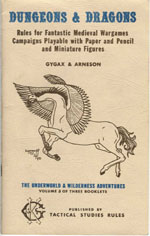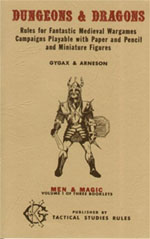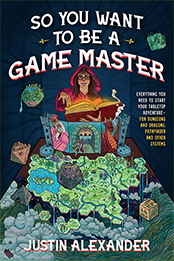
In my essay “Festishizing Balance“, I talked about the ugly side of balance: The point where the obsessive desire to measure up against some arbitrary baseline results in people needlessly acting against their own best interests.
But I also made a point in that essay of making it clear that balance is also an important element of game and scenario design. On the other hand, a lot of confusion arises because people actually mean very different things when they talk about “balance”. In my Reactions to OD&D yesterday I talked about Gygax looking for a “very different type of balance” than the balance of mechanical equivalence.
Let’s talk about this for a bit.
CONCEPT BALANCE: Concept balance maintains that all character concepts should be equally viable. In other words, the guy wanting to play Conan the Barbarian and the guy wanting to play Robin Hood should both be equally effective in combat. Why? Because otherwise the system is inhibiting creativity (by making it less attractive to play Conan and/or Robin Hood). In addition, these less effective character concepts serve as “traps” for inexperienced players — they think it would be cool to play Conan, but instead they find themselves always playing second fiddle to Robin Hood. It requires at least some degree of system mastery in order to recognize and avoid these traps.
NATURALISTIC BALANCE: Naturalistic balance, on the other hand, recognizes that not all character concepts are realistically equal. If you’re playing in a realistic World War II game, then the martial arts specialist is just not going to be as combat effective as the guy with a machine gun. (However, naturalistic balance should not be misunderstood as being equivalent to a desire for “realism” in a game.)
SPOTLIGHT BALANCE: With spotlight balance, characters focus on disparate types of gameplay and the balance between them is achieved by the GM making sure that all types of gameplay get an equal share of playing time. For example, when confronted with both Conan and Robin Hood, the GM needs to make sure that there are equal opportunities for both melee specialists (Conan) and ranged specialists (Robin Hood) to show off their best stuff.
THE PROBLEM WITH CONCEPT BALANCE
The problem with concept balance is that it requires you to severely limit either (a) flexibility of character creation; (b) the scope of gameplay; or (c) both.
Many advocates of concept balance will, at this juncture, attempt to degrade the concept of “flexibility” as being the “freedom to play a weakling”. While it certainly can mean that, flexibility more usefully means “I want to focus my character creation resources on gameplay X versus gameplay Y”.
The inherent imbalance of flexibility becomes apparent when you realize that different campaigns will feature different mixes of gameplay types.
A simple example of this is the difference between a campaign focusing on lots of melee fighting in the tightly confined quarters of a typical dungeon (favoring Conan) and a campaign focusing on lots of ranged fighting in the wilderness (favoring Robin Hood). A more complex example of this was the subject of my essay “Death of the Wandering Monster” — certain types of campaigns allow the spotlight balance between fighters and wizards to skew one way or the other.
Let’s make this an extreme example: If you’re playing in a campaign with little or no combat, a fighter is less useful. If you’re playing in an entirely urban campaign, druids and rangers become less useful. If you’re playing in a campaign taking place entirely within an area of antimagic, wizards become less useful.
(D&D makes an easy example for this sort of thing because one major type of character creation resource investment is neatly encapsulated in a single decision point: Class selection.)
There’s no way to “balance” the fact that fighters aren’t very effective in campaigns where there isn’t any combat without either (a) disallowing people from playing a fighter (limiting the flexbility of character creation) or (b) disallowing campaigns that don’t feature a lot of combat (limiting the scope of the game).
This is why many proponents of combat balance often focus exclusively on a character’s combat effectiveness: By narrowing the scope of the game to a single type of gameplay (combat), concept balance becomes possible.
The other way to work around this issue is to isolate each distinct style of gameplay and then make sure that all characters are balanced within each style of play. (This, of course, is another example of limiting the flexibility of character creation.)
THE PROBLEM WITH NATURALISTIC BALANCE
We’ve already touched on the problem with naturalistic balance: It invalidates character concepts and creates potentially unforeseen “booby traps” in character creation that require system mastery to avoid.
The result is that people end up with characters who aren’t fun to play. Combined with the typical modern paradigm of gaming in which character attrition is low, players can end up stuck for a very long time playing characters they don’t want to play any more.
Partial solutions to this problem include allowing players to redesign sub-par characters or switch to entirely different characters. But these are only partial solutions: If someone wants to play Robin Hood and the system doesn’t make Robin Hood a viable concept, then it doesn’t matter how many times you let them re-design the character — they still won’t be playing what they want to be playing.
THE PROBLEM WITH SPOTLIGHT BALANCE
The problem with spotlight balance is that it can mean that characters in spotlight A have to sit and watch while characters in spotlight B are doing their thing.
For example, look at the “decker problem” in cyberpunk games (such as Shadowrun). In these games, non-deckers frequently have to stand idly by and do nothing while the decker characters hack into a computer system. This problem arises partly because of scenario design (hacking frequently happens while nothing else of interest is going on) and partly because of mechanical design (actions taken while hacking take less game time than non-hacking actions).
Concept balancers would try to fix this problem by either (a) getting rid of decker play (narrowing the scope of the game); (b) requiring that all characters be capable of participating in decker play (limiting the flexibility of character creation); or (c) figuring out how to combine decker and non-decker activities into a single type of gameplay.
(For example, I understand that the most recent edition of Shadowrun uses augmented reality to effectively fold hacking into the combat-and-stealth gameplay of a typical ‘run.)
In a more general sense, spotlight balance requires that a GM be capable of designing scenarios involving more than one type of gameplay. In addition, either:
(1) The scenario must allow for both gameplay A and gameplay B to be happening simultaneously, with the GM flipping back and forth between the split party; or
(2) Characters must have at least some abiltiy to participate in all forms of gameplay.
The former, frankly, is non-trivial and requires an experienced and talented GM. The latter, however, can be mechanically achieved and is, in fact, the default method for classic D&D play.
PROBLEM? WHAT PROBLEM?
So, to sum up: The problem with concept balance is that it requires limiting the scope and flexibility of the game. The problem with naturalistic balance is that it offers unfun options. And the problem with spotlight balance is that it requires characters to sometimes NOT be in the spotlight.
But, on the flip-side, there are plenty of people who will stand up and say, “Problem? What problem?”
Some people have no problem with the scope and flexibility of the game being curtailed, if it means that they can have fun within the resulting focus.
Some people have no problem with a game requiring a certain degree of mastery, if it means that they get sensible and flexible results.
Some people have no problem with being an audience to awesome, if it means that — when their turn comes — they get to be awesome, too.
There is no One True Way to be achieved here. All of these forms of balance have their disadvantages and their advantages. Which trade-offs you prefer is going to be a matter of personal taste.
MY SWEET SPOT
With that being said, allow me to use my soapbox to talk about my own, personal sweet spot.
CONCEPT BALANCE: I like immersive roleplay and open, sandbox-style scenarios. Thus I prize both flexibility in character creation and a broad scope of potential gameplay. As a result, I have no taste for the trade-offs demanded by concept balance.
However, that doesn’t mean that the lessons of concept balance should be completely ignored. While I don’t necessarily believe that all character concepts need to be legitimate options, I do believe that all legitimate character options should be viable in the game system.
NATURALISTIC BALANCE: My preference for immersive roleplay and sandbox-style scenarios similarly makes naturalistic balance appealing to me. The need for system mastery, on the other hand, is not inherently appealing to me, but flexibility and meaningful choice both require the possibility that poor choices can be made. Ergo, I’m not particularly averse to the negative aspects of naturalistic balance, while remaining open to its positive aspects.
SPOTLIGHT BALANCE: I like my players to have many different gameplay options for overcoming a given obstacle. And I recognize that giving players meaningful choice in character creation means allowing them to choose where to focus their character creation resources.
Therefore, I embrace spotlight balance.
Fortunately, when you embrace open-ended scenario design, spotlight balance tends to take care of itself. When you give players the ability to craft their own course of action, they’ll defend their own interests and pursue those strategies and tactics which best reflect their own strengths. (You’ll need to watch out for players who get excluded from the group’s decision-making process, but that’s a group dynamic that will cause problems far beyond the issues raised by spotlight balance and would need to be dealt with in any case.)
I also tend to believe that, when spotlight balance is working, the problems commonly associated with it aren’t actually meaningful problems. Even if all of the PCs are perfectly balanced for combat and your entire game is completely dedicated to combat, each PC is still only capable of being at the center of attention for a limited amount of time. (If there are X PCs, then that time is limited — on average — to 1/Xth of the game session.) If you don’t like being an audience for the awesome things the other players are doing, then you’re never going to be satisfied with anything except solo and one-on-one play. (Me? I like having an audience for my escapades and I like watching the clever escapades of others.)
So, in my opinion, most people who protest that they have a problem with spotlight balance acutally mean that they have a problem with spotlight imbalance — in other words, someone else is getting more than their fair share of the spotlight.
What I will concede is that spotlight play is not something that can be mechanically enforced within the traditional structure of a roleplaying game. (It can be mechanically enabled, but that’s different.) Ultimately the GM, working in concert with the group dynamic, must make sure that the spotlight gets turned to each PC in turn. This is something that must be managed in the moment. It can’t even be easily quantified. Knowing where, when, and how to focus a spotlight depends on the tastes of your players and the circumstances of the session. It’s a matter of pacing and narrative need, coupled with practicality and an honest gauge of players’ current interests, attention, and energy. It’s more an art than a science.
As a final note, I’ll point out that the exact mixture of concept, naturalistic, and spotlight balance depends on the game and the campaign concept I’m running at the time. Just as there’s no One True Way, in my experience there’s also no One Size Fits All solution to these issues.














